Practice Corner MCQs
Quiz Summary
0 of 108 Questions completed
Questions:
Information
You have already completed the quiz before. Hence you can not start it again.
Quiz is loading…
You must sign in or sign up to start the quiz.
You must first complete the following:
Results
Results
0 of 108 Questions answered correctly
Your time:
Time has elapsed
You have reached 0 of 0 point(s), (0)
Earned Point(s): 0 of 0, (0)
0 Essay(s) Pending (Possible Point(s): 0)
Categories
- Not categorized 0%
- 1
- 2
- 3
- 4
- 5
- 6
- 7
- 8
- 9
- 10
- 11
- 12
- 13
- 14
- 15
- 16
- 17
- 18
- 19
- 20
- 21
- 22
- 23
- 24
- 25
- 26
- 27
- 28
- 29
- 30
- 31
- 32
- 33
- 34
- 35
- 36
- 37
- 38
- 39
- 40
- 41
- 42
- 43
- 44
- 45
- 46
- 47
- 48
- 49
- 50
- 51
- 52
- 53
- 54
- 55
- 56
- 57
- 58
- 59
- 60
- 61
- 62
- 63
- 64
- 65
- 66
- 67
- 68
- 69
- 70
- 71
- 72
- 73
- 74
- 75
- 76
- 77
- 78
- 79
- 80
- 81
- 82
- 83
- 84
- 85
- 86
- 87
- 88
- 89
- 90
- 91
- 92
- 93
- 94
- 95
- 96
- 97
- 98
- 99
- 100
- 101
- 102
- 103
- 104
- 105
- 106
- 107
- 108
- Current
- Review
- Answered
- Correct
- Incorrect
-
Question 1 of 108
1. Question
ATP is known as energy currency of the cell because
CorrectIncorrectHint
c
-
Question 2 of 108
2. Question
Respiratory substrates are the organic substances which are ____ during respiration to liberate energy.
CorrectIncorrectHint
(a) Respiration is an oxidative process in which respiratory substrates are oxidised to liberate energy inside the living cells. The common respiratory substrates are carbohydrates, proteins, fats and organic acids. The most common respiratory substrate is glucose.
-
Question 3 of 108
3. Question
Instantaneous source of energy is
CorrectIncorrectHint
d
-
Question 4 of 108
4. Question
Complete the following biochemical equation of respiration and select the correct answer.
\(\mathrm{C}_6 \mathrm{H}_{12} \mathrm{O}_6+6 \mathrm{O}_2 \longrightarrow\) ______ + _____+ ______CorrectIncorrectHint
d
-
Question 5 of 108
5. Question
The respiration in germinating seeds produces energy which can be detected in the form of
CorrectIncorrectHint
(b) In germinating seeds, imbibition takes place. Their energy is released in the form of heat (heat of wetting).
-
Question 6 of 108
6. Question
Plants can get along without respiratory organ because
CorrectIncorrectHint
d
-
Question 7 of 108
7. Question
Rise in the water level from \(X\) to \(Y\) in the given experimental set-up demonstrates
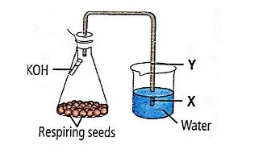 CorrectIncorrect
CorrectIncorrectHint
(a) Oxygen required for aerobic respiration is taken up from the air of the apparatus. Carbon dioxide released during aerobic respiration is absorbed by potassium hydroxide (KOH). Therefore, a partial vacuum is created in the conical flask. This causes the rise of water in the bent tube. That oxygen is consumed during aerobic respiration can be tested by taking a burning splinter into the conical flask, which gets extinguished.
-
Question 8 of 108
8. Question
The pathway of respiration common in all living organisms is \(\underline{X}\); it occurs in the \(\underline{Y}\) and the products formed are two molecules of \(Z\).
Identify \(X, Y\) and \(Z\) in the above paragraph and select the correct answer.\(
\begin{array}{|l|l|l|l|}
\hline & \text { X } & \text { Y } & \text { Z } \\
\hline \text { (a) } & \text { EMP pathway } & \text { mitochondrion } & \text { pyruvic acid } \\
\hline \text { (b) } & \text { EMP pathway } & \text { cytoplasm } & \text { pyruvic acid } \\
\hline \text { (c) } & \text { Krebs’ cycle } & \text { cytoplasm } & \text { acetyl CoA } \\
\hline \text { (d) } & \text { Krebs’ cycle } & \text { mitochondrion } & \text { acetyl CoA } \\
\hline
\end{array}
\)CorrectIncorrectHint
b
-
Question 9 of 108
9. Question
Select the wrong statement with respect to glycolysis.
CorrectIncorrectHint
(d) Glucose is phosphorylated to glucose-6-phosphate by ATP in the presence of enzyme hexokinase or glucokinase and \(\mathrm{Mg}^{2+}\)
-
Question 10 of 108
10. Question
Study the given steps of glycolysis and identify the enzymes (i), (ii) and (iii) responsible for carrying out these steps.
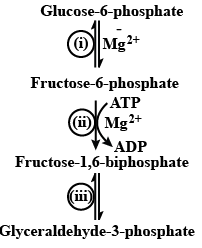 CorrectIncorrect
CorrectIncorrectHint
(a) Glucose-6-phosphate changes its isomer fructose-6phosphate with the help of enzyme phosphohexose isomerase. Fructose-6-phosphate is phosphorylated to fructose-1,6bisphosphate in the presence of phosphofructokinase and \(\mathrm{Mg}^{+2}\). Further this fructose-1,6-bisphosphate is splits into glyceraldehyde3-phosphate and dihydroxyacetone phosphate by the enzyme aldolase
-
Question 11 of 108
11. Question
The flow chart given below shows the steps in glycolysis. Select the option that correctly fills in the missing steps A, B, C and D.
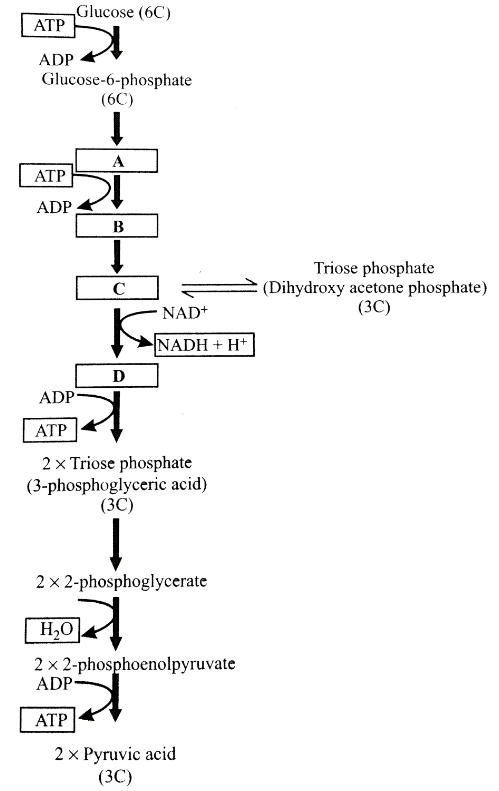
\(
\begin{array}{|l|l|l|l|l|}
\hline & \text { A } & \text { B } & \text { C } & \text { D } \\
\hline \text { (a) } & \begin{array}{l}
\text { Fructose-6- } \\
\text { phosphate }
\end{array} & \begin{array}{l}
\text { Fructose -1, 6- } \\
\text { biphosphate }
\end{array} & \text { 3-PGAL } & \begin{array}{l}
\text { 1,3-biphospho- } \\
\text { glyceric acid }
\end{array} \\
\hline \text { (b) } & \begin{array}{l}
\text { Fructose-1, 6- } \\
\text { biphosphate }
\end{array} & \text { 3-PGAL } & \begin{array}{l}
1,3 \text {-biphospho- } \\
\text { glyceric acid }
\end{array} & \text { 3 PGA } \\
\hline \text { (c) } & \text { 3-PGA } & \begin{array}{l}
1,3 \text {-biphospho- } \\
\text { glyceric acid }
\end{array} & \text { 3-PGAL } & \begin{array}{l}
\text { Fructose-1, 6- } \\
\text { biphosphate }
\end{array} \\
\hline \text { (d) } & \begin{array}{l}
\text { Fructose-1, 6- } \\
\text { biphosphate }
\end{array} & \begin{array}{l}
\text { Fructose -6- } \\
\text { phosphate }
\end{array} & \text { 3-PGAL } & \begin{array}{l}
1,3 \text {-biphospho- } \\
\text { glyceric acid }
\end{array} \\
\hline
\end{array}
\)CorrectIncorrectHint
a
-
Question 12 of 108
12. Question
Which of the following are isomers?
CorrectIncorrectHint
d
-
Question 13 of 108
13. Question
Which of the following steps during glycolysis is associated with utilisation of ATP?
CorrectIncorrectHint
. (d) : In the initial phase (energy spending phase) of glycolysis, the hexoses (i.e. glucose and fructose) are phospherylated in a reaction that uses ATP at two steps: First in the conversion of glucose into glucose-6-phosphate and second in the conversion of fructose-6-phosphate to fructose-1, 6-bisphosphate. These reactions are catalysed by the hexokinase and phosphofructokinase respectively.
\(
\text { Glucose + ATP } \underset{\mathrm{Mg}^{2+}}{\stackrel{\text { hexokinase }}{\longrightarrow}} \text { Glucose-6-phosphate + ADP }
\)
\(
\text { Fructose }-6-\text { phosphate }+ \text { ATP } \frac{\text { Phospho-fructokinase }}{\mathrm{Mg}^{2+}} \text { F ructose }-1,6-\text { biphosphate }+ ADP
\) -
Question 14 of 108
14. Question
Which of the following conversions involve ATP synthesis during glycolysis?
CorrectIncorrectHint
(c) In the energy conserving phase of glycolysis, the conversion of BPGA to PGA is catalysed by phosphoglycerate kinase. The phosphate on carbon 1 is transferred to a molecule of ADP, yielding ATP and 3-phosphoglycerate. This type of ATP synthesis, traditionally referred to as substrate-level phosphorylation, involves the direct transfer of a phosphate group from a substrate molecule to ADP, to form ATP.
\(
1,3 \text { – bisphosphoglycerate }+\mathrm{ADP} \underset{\mathrm{Mg}^{2+}}{\stackrel{\text { Phosphoglyceratekinase }}{\rightleftharpoons}} 3 \text { – phosphoglycerate }+ \text { ATP }
\) -
Question 15 of 108
15. Question
At the end of glycolysis, \(X\) is the net energy gain from one molecule of glucose via \(Y\), but there is also energy stored in the form of \(Z\). Identify \(X, Y\) and \(Z\).
\(
\begin{array}{|l|l|l|l|}
\hline & \mathbf{X} & \mathbf{Y} & \mathbf{Z} \\
\hline \text { (a) } & \mathbf{1} \text { ATP } & \text { Oxidative phosphorylation } & N A D H+H^{+} \\
\hline \text { (b) } & \mathbf{2} \text { ATPs } & \text { Oxidative phosphorylation } & N A D H+H^{+} \\
\hline \text { (c) } & \mathbf{1} \text { ATP } & \text { Substrate level phosphorylation } & F A D H_2 \\
\hline \text { (d) } & \mathbf{2} \text { ATPs } & \text { Substrate level phosphorylation } & N A D H+H^{+} \\
\hline
\end{array}
\)CorrectIncorrectHint
d
-
Question 16 of 108
16. Question
The net gain of ATP molecules in glycolysis during aerobic respiration is
CorrectIncorrectHint
d
-
Question 17 of 108
17. Question
The end product of glycolysis is
CorrectIncorrectHint
(a) Pyruvic acid is the end product of glycolysis.
-
Question 18 of 108
18. Question
What is true about the end products of glycolysis?
CorrectIncorrectHint
(a) In glycolysis, two molecules of ATP are consumed during two phosphorylation reactions to form fructose 1, 6-bisphosphate. In return, four molecules of ATP are produced by substrate-level phosphorylation (conversion of 1,3-bisphosphoglycerate to 3-phosphoglycerate and phosphoenol pyruvate to pyruvate). Two molecules of \(\mathrm{NADH}_2\) are formed at the time of oxidation of glyceraldehyde 3-phosphate to 1, 3-bisphosphoglycerate. The net reaction of glycolysis is as follows:
\(
\text { Glucose }+2 \mathrm{NAD}^{+}+2 \mathrm{ADP}+2 \mathrm{H}_3 \mathrm{PO}_4 \rightarrow 2 \text { Pyruvate }+2 \mathrm{NADH}+2 \mathrm{H}^{+}+2 \text { ATP }
\) -
Question 19 of 108
19. Question
During the process of aerobic respiration, (i) gets oxidised and its electrons get transferred to the electron transport chain while in photosynthesis, (ii) gets oxidised to transfer molecules to the electron transport chain.
CorrectIncorrectHint
(d) The oxidative breakdown of respiratory substrates with the help of atmospheric \(\mathrm{O}_2\) is known as aerobic respiration. It involves the complete breakdown of substrates into \(\mathrm{CO}_2\) and water, releasing energy. For example, the simple chemical equation for aerobic breakdown of glucose is
\(
\mathrm{C}_6 \mathrm{H}_{12} \mathrm{O}_6+6 \mathrm{O}_2 \rightarrow 6 \mathrm{CO}_2+6 \mathrm{H}_2 \mathrm{O}+2870 \mathrm{~kJ} / 686 \mathrm{KCal}
\)
While during photosynthesis chlorophyll gets oxidised to transfer molecules to the electron transport chain. -
Question 20 of 108
20. Question
Match column I with column II and select the correct option from the codes given below.
\(
\begin{array}{|l|l|l|l|}
\hline & \text { Column I } & & \text { Column II } \\
\hline \text { A. } & \begin{array}{l}
\text { Fats made of three fatty acid } \\
\text { chains attached to glycerol }
\end{array} & \text { (i) } & \text { Glycogen } \\
\hline \text { B. } & \begin{array}{l}
\text { Glycolysis metabolite made } \\
\text { from glycerol }
\end{array} & \text { (ii) } & \text { Glyceraldehyde } \\
\hline \text { C. } & \text { Storage form of glucose } & \text { (iii) } & \text { Triglycerides } \\
\hline \text { D. } & \begin{array}{l}
\text { Common respiratory } \\
\text { substrate of glycolysis }
\end{array} & \text { (iv) } & \text { Glucose } \\
\hline
\end{array}
\)CorrectIncorrectHint
b
-
Question 21 of 108
21. Question
Ethyl alcohol fermentation occurs in
CorrectIncorrectHint
(c) Ethyl alcohol fermentation occurs in fungi such as Rhizopus, yeast, and bacteria.
Lactobacillus and muscles of humans do anaerobic respiration but form lactic acid as an end product. (i.e., Lactic acid fermentation) -
Question 22 of 108
22. Question
Anaerobic respiration takes place in
CorrectIncorrectHint
(c) Anaerobic respiration is a type of cellular respiration where respiration takes place in the absence of oxygen. It takes place in the cytoplasm since most anaerobic cells do not have specialized organelles whereas aerobic respiration takes place in the mitochondria.
-
Question 23 of 108
23. Question
Which of the molecule listed below is a product of fermentation of glucose by yeast?
CorrectIncorrectHint
(b) In yeast, the incomplete oxidation of glucose is achieved under anaerobic conditions by sets of reactions where pyruvic acid is converted to \(\mathrm{CO}_2\) and \(\mathrm{C}_2 \mathrm{H}_5 \mathrm{OH}\) (ethanol). So, the correct answer is (b).
-
Question 24 of 108
24. Question
A test tube containing molasses solution and yeast is kept in a warm place overnight. The gas collected from this mixture
CorrectIncorrectHint
Yeast do anaerobic fermentation by consuming sugar and forming ethanol and \(\mathrm{CO}_2\). As Molasses mainly contains sugar, yeast will do anaerobic fermentation of the molasses and forms \(\mathrm{CO}_2\) gas as a by-product.
This \(\mathrm{CO}_2\) gas can (i) extinguish the flame, and (ii) Turns lime water milky. So, the correct answer is (d). -
Question 25 of 108
25. Question
Which of the following options does not hold true regarding anaerobic respiration or fermentation?
CorrectIncorrectHint
(a) Fermentation is the incomplete oxidation of glucose under anaerobic conditions by sets of reactions where pyruvic acid is converted to \(\mathrm{CO}_2\) and ethanol (alcoholic fermentation) or lactic acid (lactic acid fermentation). In fermentation, there is a net gain of only 2 ATP molecules for each molecule of glucose degraded to pyruvic acid.
-
Question 26 of 108
26. Question
Identify the enzymes 1 and 2 in the given reaction and select the correct option.

\(
\begin{array}{|l|l|l|}
\hline & 1 & 2 \\
\hline \text { (a) } & \text { Alcohol dehydrogenase } & \text { Pyruvate decarboxylase } \\
\hline \text { (b) } & \text { Alcohol decarboxylase } & \text { Pyruvate dehydrogenase } \\
\hline \text { (c) } & \text { Pyruvate decarboxylase } & \text { Alcohol dehydrogenase } \\
\hline \text { (d) } & \text { Pyruvate dehydrogenase } & \text { Alcohol dehydrogenase } \\
\hline
\end{array}
\)CorrectIncorrectHint
(c) The given reaction represents alcoholic fermentation. In alcoholic fermentation, pyruvate is converted into ethanol in a two-step pathway. Ethyl alcohol fermentation is quite common in fungi (e.g., Rhizopus, yeast) and bacteria. In yeast, pyruvate is decarboxylated to form acetaldehyde which is then reduced by NADH to form ethanol.

-
Question 27 of 108
27. Question
What does \(A, B\) and \(C\) depict in the given pathways of anaerobic respiration?

\(
\begin{array}{|l|l|l|l|}
\hline & \text { A } & \text { B } & \text { C } \\
\hline \text { (a) } & N A D H+H^{+} \rightarrow N A D^{+} & N A D^{+} \rightarrow N A D H+H^{+} & N A D^{+} \rightarrow N A D H+H^{+} \\
\hline \text { (b) } & N A D H+H^{+} \rightarrow N A D^{+} & N A D H+H^{+} \rightarrow N A D^{+} & N A D^{+} \rightarrow N A D H+H^{+} \\
\hline \text { (c) } & N A D^{+} \rightarrow N A D H+H^{+} & N A D H+H^{+} \rightarrow N A D^{+} & N A D H+H^{+} \rightarrow N A D^{+} \\
\hline \text { (d) } & N A D^{+} \rightarrow N A D H+H^{+} & N A D H+H^{+} \rightarrow N A D^{+} & N A D^{+} \rightarrow N A D H+H^{+} \\
\hline
\end{array}
\)CorrectIncorrectHint
(c) In glycolysis, \(\mathrm{NAD}+\) oxidises glyceraldehyde-3-phosphate by acting as a reducing agent and convert it to 3 -phosphoglyceric acid.
\(
\left(\mathrm{NAD}^{+}+\mathrm{H}^{+} \rightarrow \mathrm{NADH}\right)
\)
In the absence of oxygen Pyruvic acid to either Lactic acid or ethanol depending on the organism.
1. In Lactic acid fermentation – pyruvic acid converts into Lactate while regenerating the \(\mathrm{NAD}^{+}\).
\(
\left(\mathrm{NADH} \rightarrow \mathrm{NAD}^{+}+\mathrm{H}^{+}\right)
\)
2. In Alcoholic fermentation – pyruvic acid converts into ethanol while regenerating the \(\mathrm{NAD}^{+}\).
\(
\left(\mathrm{NADH} \rightarrow \mathrm{NAD}^{+}+\mathrm{H}^{+}\right)
\) -
Question 28 of 108
28. Question
Though vertebrates are aerobes, but their (i) show anaerobic respiration during (ii). During this, (iii) of skeletal muscle fibres is broken down to release lactic acid and energy. Lactic acid, if accumulates causes muscle fatigue.
Fill up the blanks in the above paragraph and select the correct option.\(
\begin{array}{|l|l|l|l|}
\hline & \text { (i) } & \text { (ii) } & \text { (iii) } \\
\hline \text { (a) } & \text { skeletal muscles } & \text { heavy exercise } & \text { glucose } \\
\hline \text { (b) } & \text { skeletal muscles } & \text { mild exercise } & \text { glycogen } \\
\hline \text { (c) } & \text { skeletal muscles } & \text { heavy exercise } & \text { glycogen } \\
\hline \text { (d) } & \text { cardiac muscles } & \text { heavy exercise } & \text { glycogen } \\
\hline
\end{array}
\)CorrectIncorrectHint
(a) Muscle fatigue is the reduction in force of contraction of a muscle after prolonged stimulation. In the absence of oxygen, the skeletal muscle of human beings can contract for a short time, but it gets fatigued soon. This is due to the fact that in the absence of oxygen, products of glycolysis mainly lactic acid is not disposed of and accumulate in the muscles. This leads to muscle fatigue and pain in the muscles. A muscle gets fatigued sooner after a strenuous exercise than after a mild exercise. Faster breathing for some time after a strenuous exercise supplies extra oxygen disposes of excess lactic acid and muscle fatigue disappears.
So the correct option is ‘i-Skeletal muscles; ii-heavy exercise; iii-glucose’. -
Question 29 of 108
29. Question
\(\text { Pyruvic acid }+A \underset{F M N, Z n^{2+}}{\stackrel{\text { Lactate dehydrogenase }}{\longrightarrow}} B+C\)
\(
\begin{array}{|l|l|l|l|}
\hline & \text { A } & \text { B } & \text { C } \\
\hline \text { (a) } & N A D H & \text { Lactic acid }+CO_2 & N A D^{+} \\
\hline \text { (b) } & N A D H & \text { Lactic acid } & N A D^{+} \\
\hline \text { (c) } & N A D^{+} & \text {Lactic acid } & N A D H \\
\hline \text { (d) } & N A D^{+} & \text {Lactic acid }+CO_2 & N A D H \\
\hline
\end{array}
\)CorrectIncorrectHint
(b) from the diagram, we can say
So, the correct option is ‘A-NADH; B- Lactic acid; C-NAD+’.
-
Question 30 of 108
30. Question
Select the incorrectly matched pair.
CorrectIncorrectHint
(b) Lactic acid fermentation occurs in lactic acid bacteria (e.g., Lactobacillus), some fungi and muscles. In lactic acid fermentation, pyruvic acid produced in glycolysis is directly reduced by NADH to form lactic acid. No \(\mathrm{CO}_2\) is produced. The enzyme is lactate dehydrogenase which requires \(\mathrm{FMN}\) and \(\mathrm{Zn}^{2+}\)
\(
\text { Pyruvic acid + NADH } \underset{\text { FMN }, \mathrm{Zn}^{2+}}{\stackrel{\text { Lactate denydrogenase }}{\longrightarrow}} \text { Lactic acid }+\mathrm{NAD}^{+}
\) -
Question 31 of 108
31. Question
Fermentation is represented by the equation
CorrectIncorrectHint
(b) Fermentation is a metabolic process, that converts sugar to acids, gases and alcohol. It occurs in yeast and bacteria, but also in oxygen-starved muscle cells, as in the case of lactic acid fermentation. It could be represented by the equation for alcoholic fermentation:
\(
\mathrm{C}_6 \mathrm{H}_{12} \mathrm{O}_6—->2 \mathrm{C}_2 \mathrm{H}_5 \mathrm{OH}+2 \mathrm{CO}_2+18 \mathrm{k} \mathrm{~cal}
\) -
Question 32 of 108
32. Question
The given experimental set-up demonstrates
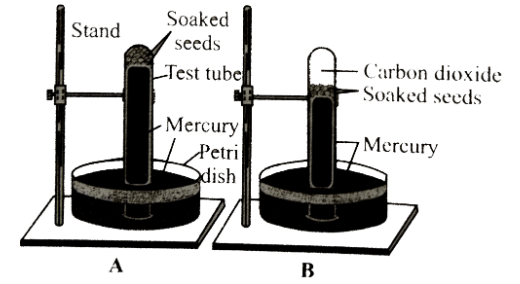 CorrectIncorrect
CorrectIncorrectHint
(c) In the test tube full of mercury (figure A) there is no air and, therefore, the introduced soaked seeds do not get air for their respiration. But they are capable of respiration in the absence of oxygen as is indicated by the evolution of carbon dioxide(figure B). Therefore, anaerobic respiration takes place in the seeds in the absence of free oxygen. The experiment also shows that \(\mathrm{CO}_2\) is evolved in anaerobic respiration of seeds.
So the correct answer is ‘Anaerobic respiration’. -
Question 33 of 108
33. Question
Mercury \((\mathrm{Hg})\) is generally used in anaerobic respiration experiments because it does not react with
CorrectIncorrectHint
b
-
Question 34 of 108
34. Question
Which of the following describes significance of fermentation?
(i) Production of alcohol in brewing industry
(ii) Making of dough in baking industry
(iii) Curing of tea and tobacco
(iv) Production of vinegar by acetic acid bacteriaCorrectIncorrectHint
(d) Alcoholic fermentation is used in the brewing industry for the production of various types of beer, whiskey and other wines.
Carbon dioxide of alcoholic fermentation is used in the baking industry for making the bread spongy.
Tea and tobacco leaves are curved (or removed of their bitterness) and provided with a fine flavor through fermentation. Vinegar is obtained by the fermentation activity of acetic acid bacteria.
So the correct answer is ‘(i),(ii),(iii) and (iv)’. -
Question 35 of 108
35. Question
Dough kept overnight in warm weather becomes soft and spongy due to
CorrectIncorrectHint
(c) Dough kept overnight in warm weather becomes soft and spongy because of fermentation. Fermentation is a metabolic process that converts sugar to acids, gases, and/or alcohol. It occurs in yeast and bacteria, but also in oxygen-starved muscle cells, as in the case of lactic acid fermentation. So, fermentation occurs in dough causing conversion of sugars to acids or alcohols and \(\mathrm{CO}_2\) which makes the dough soft and spongy. Thus option B is correct. Absorption of carbon dioxide from the atmosphere, cohesion and osmosis can not make the dough soft and spongy. Thus, other options are incorrect.
-
Question 36 of 108
36. Question
Site of Krebs’ cycle in mitochondria is
CorrectIncorrectHint
(b) Krebs cycle(or TCA cycle) takes place in mitochondrial matrix. A 2-carbon acetyl \(\mathrm{CoA}\) acts as substrate entrant for Krebs cycle and 4-carbon oxaloacetate acts as acceptor molecule.
-
Question 37 of 108
37. Question
Read the given statements and select the correct option.
Statement 1: Glycolysis occurs in mitochondrial matrix.
Statement 2: Krebs’ cycle occurs on cristae of mitochondria.CorrectIncorrectHint
(d) Glycolysis is the process of conversion of glucose to pyruvate. It occurs in the cytoplasmic matrix.
Krebs’ cycle occurs in the mitochondrial matrix and generates a pool of chemical energy (ATP, NADH, and \(\mathrm{FADH} 2\) ) from the oxidation of pyruvate, the end product of glycolysis.
Therefore, both statements are incorrect.
So, the correct options are (d). -
Question 38 of 108
38. Question
Fate of pyruvic acid during aerobic respiration is
CorrectIncorrectHint
(c) During aerobic respiration, pyruvic acid which is formed during glycolysis enters the mitcohondrial matrix. It undergoes oxidative decarboxylation to produce \(\mathrm{CO}_2\) and NADH. The product combines with sulfur-containing coenzyme A to form acetyl CoA. This reaction is catalyzed by an enzyme complex pyruvate dehydrogenase. This step is called link reaction or gateway step as it links glycolysis with Krebs’ cycle.
\(
\text { Pyruvic acid }+\mathrm{COA}+\mathrm{NAD}^{+} \underset{\text { Pyruvate dehyrogenase }}{\stackrel{\mathrm{Mg}^{2+}}{\longrightarrow}} \text { Acetyl } \mathrm{CoA}+\mathrm{CO}_2+\mathrm{NADH}+\mathrm{H}^{+}
\) -
Question 39 of 108
39. Question
Pyruvate dehydrogenase is used in converting
CorrectIncorrectHint
(c) After the glycolysis, pyruvate goes from the cytosol into the mitochondrial intermembrane space and gets converted to Acetyl CoA by an enzyme called Pyruvate dehydrogenase.

-
Question 40 of 108
40. Question
Identify A and B in the given reaction.
\(
\text { Pyruvic acid }+\mathrm{CoA}+\mathrm{NAD}^{+} \underset{\text { Pyruvate dehydrogenase }}{\stackrel{\mathrm{Mg}^{2+}}{\longrightarrow}} \mathrm{A}+\mathrm{B}+\mathrm{NADH}+\mathrm{H}^{+}
\)\(
\begin{array}{|l|l|l|}
\hline & \text { A } & \text { B } \\
\hline \text { (a) } & \mathrm{PEP} & \mathrm{CO}_2 \\
\hline \text { (b) } & \text { Acetyl CoA } & \mathrm{CO}_2 \\
\hline \text { (c) } & \mathrm{CO}_2 & \mathrm{H}_2 \mathrm{O} \\
\hline \text { (d) } & \text { Acetyl CoA } & \mathrm{H}_2 \mathrm{O} \\
\hline
\end{array}
\)CorrectIncorrectHint
(b) During aerobic respiration, pyruvic acid which is formed during glycolysis enters mitochondrial matrix. It undergoes oxidative decarboxylation to produce \(\mathrm{CO}_2\) and \(\mathrm{NADH}\). The product combines with sulfur-containing coenzyme A to form acetyl CoA. This reaction is catalyzed by an enzyme complex pyruvate dehydrogenase. This step is called link reaction or gateway step as it links glycolysis with Krebs’ cycle.
\(
\begin{aligned}
& \text { Pyruvicacid }+\mathrm{COA}+\mathrm{NAD}^{+} \frac{\mathrm{Mg}^{2+}}{\text { Pyruvate dehydrogenase }} \text { AcetylCoA }+\mathrm{CO}_2+\mathrm{NADH}+ \mathrm{H}^{+}
\end{aligned}
\) -
Question 41 of 108
41. Question
Which step is called gateway step/link reaction in aerobic respiration?
CorrectIncorrectHint
(b)
-
Question 42 of 108
42. Question
TCA cycle is named so because
CorrectIncorrectHint
(b) During aerobic respiration, pyruvic acid which is formed during glycolysis enters the mitochondrial matrix. It undergoes oxidative decarboxylation to produce \(\mathrm{CO}_2\) and \(\mathrm{NADH}\). The product combines with sulfur-containing coenzyme A to form acetyl CoA. This reaction is catalyzed by an enzyme complex pyruvate dehydrogenase. This step is called link reaction or gateway step as it links glycolysis with Krebs’ cycle.Pyruvic acid + COA +
\(
\text { Pyruvic acid }+\mathrm{COA}+ \mathrm{NAD}^{+} \underset{\text { Pyruvate dehydrogenase }}{\stackrel{\mathrm{Mg}^{2+}}{\longrightarrow}} \text { Acetyl } \mathrm{CoA}+\mathrm{CO}_2+\mathrm{NADH}+\mathrm{H}^{+}
\) -
Question 43 of 108
43. Question
Krebs’ cycle starts with the formation of a six-carbon compound by reaction between
CorrectIncorrectHint
(b) Acetyl CoA (2-carbon compound) combines with oxaloacetate (4-carbon compound) in the presence of condensing enzyme citrate synthase to form a tricarboxylic 6-carbon compound called citric acid. It is the first product of kerbs’ cycle. CoA is liberated.
\(
\text { AcetylCoA }+ \text { Oxaloaceticacid }+\mathrm{H}_2 \mathrm{O} \text { Citrate synthase Citrate }+\mathrm{CoA}
\) -
Question 44 of 108
44. Question
In Krebs’ cycle, OAA accepts acetyl CoA to form
CorrectIncorrectHint
(a) Citric acid cycle is also called as Krebs cycle or tricarboxylic acid cycle. It is a metabolic cycle through which aerobic organisms obtain their energy. Pyruvate produced in glycolysis first gets converted into acetyl CoA before entering the citric acid cycle. This acetyl \(\mathrm{CoA}\) is accepted by oxaloacetic acid (OAA) to form citric acid, the first product of the cycle. Thus, the correct answer is ‘Citric acid.’
-
Question 45 of 108
45. Question
Which of the following is a 4-carbon compound?
CorrectIncorrectHint
(a) Oxaloacetic acid is a \(4 \mathrm{C}\) compound, \(\mathrm{HO}_2 \mathrm{CCH}_2 \mathrm{COCO}_2 \mathrm{H}\), that plays an integral role in the Krebs cycle.
The anion, oxaloacetate, reacts with the acetyl group, from acetyl coenzyme A to form citrate. -
Question 46 of 108
46. Question
Identify \(X, Y\) and \(Z\) in the given diagram representing steps of citric acid cycle and select the correct option.
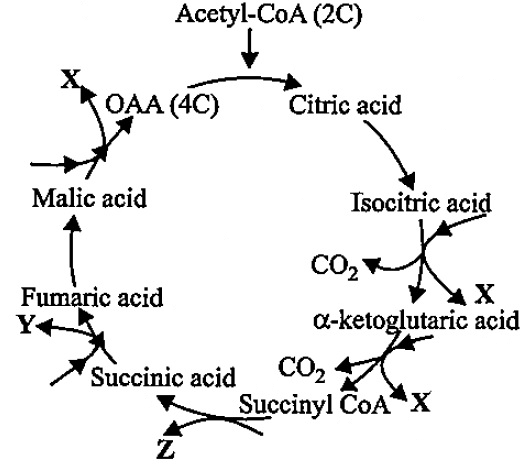
\(
\begin{array}{|l|l|l|l|}
\hline & \mathbf{X} & \mathbf{Y} & \mathbf{Z} \\
\hline \mathbf{( a )} & G T P & N A D H_2 & F A D H_2 \\
\hline \text { (b) } & F A D H_2 & N A D H_2 & G T P \\
\hline(\mathbf{c}) & N A D H_2 & F A D H_2 & G T P \\
\hline \text { (d) } & \mathrm{CO}_2 & N A D H_2 & A D P \\
\hline
\end{array}
\)CorrectIncorrectHint
c
-
Question 47 of 108
47. Question
Consider the first reaction of TCA cycle.
\(
\text { Acetyl } \mathrm{COA}+\mathrm{OAA}+\mathrm{H}_2 \mathrm{O} \underset{\text { sunthase }}{\stackrel{\text { Citrate }}{\longrightarrow}}(A)+\mathrm{COA}
\)
What is true about compound A?CorrectIncorrectHint
(d) The TCA cycle starts with the condensation of acetyl group with oxaloacetic acid and water to yield citric acid. It is tricarboxylic 6-carbon compound and undergoes reorganisation in the presence of iron-containing enzyme aconitase first forming cis aconitrate and releasing water.
-
Question 48 of 108
48. Question
Identify enzyme A in the given reaction of Krebs’ cycle
\(\underset{(4 C)}{\mathrm{OA} \mathrm{A}}+\mathrm{Accetyl \textrm {-CoA }}+\mathrm{H}_2 \mathrm{O} \stackrel{\mathrm{A}}{\rightarrow}\) Citric acid \(+\underset{(6 \mathrm{C})}{\mathrm{CoA}}\)
CorrectIncorrectHint
b
-
Question 49 of 108
49. Question
Krebs’ cycle is also called metabolic sink as it is a common pathway for breakdown of
CorrectIncorrectHint
(a) Krebs’ cycle also known as TCA cycle or citric acid cycle, is a common pathway of oxidative breakdown of carbohydrates, fatty acids and amino acids. Amino acids enter the Krebs’ cycle directly as glutamate (for \(\alpha\)-Ketoglutarate) and aspartate (for oxaloacetate) after their deamination. Fats produce fatty acids and glycerol. Glycerol is phosphorylated and oxidized to form glyceraldehyde 3 -phosphate. Fatty acids undergo \(\beta\)-oxidation to produce acetyl CoA. Acetyl CoA enters Krebs’ cycle.
So the correct answer is ‘Carbohydrates, fats and proteins (amino acids)’. -
Question 50 of 108
50. Question
The intermediate product between \(\alpha\)-ketoglutaric acid and succinic acid in TCA cycle is
CorrectIncorrectHint
(b) Succinyl CoA is an important intermediate in the citric acid cycle, where it is synthesized from a-ketoglutarate by \(\alpha\)-ketoglutarate dehydrogenase through decarboxylation. During the process, coenzyme A is added. Succinyl-CoA is an intermediate of the citric acid cycle and can be readily incorporated there. Thus, the correct answer is ‘Succinyl-CoA.’
-
Question 51 of 108
51. Question
Select the correct sequence of formation of given intermediates of Krebs’ cycle.
CorrectIncorrectHint
(c) In Kreb’s cycle:
1. Dehydrogenation: This process converts succinate into 4 carbon fumarate with the aid of enzyme, succinate dehydrogenase, and liberates a pair of hydrogen atoms.
2. Hydration. This process changes fumarate into 4- carbon maltate in the presence of water and an enzyme furmarase.
3. Dehydrogenation: This process restores oxaloacetate by removing a pair of hydrogen atoms from maltate with the help of the enzyme malate dehydrogenase.
So, the correct answer is ‘Succinate \(\rightarrow\) Fumarate \(\rightarrow\) Malate \(\rightarrow\) OAA’. -
Question 52 of 108
52. Question
Substrate level phosphorylation occurs during which step of Krebs’ cycle?
CorrectIncorrectHint
(a) In Krebs cycle, during the conversion of Succinyl-CoA to succinic acid, GTP is produced from GDP which being unstable immediately changes to ATP. Since ATP synthesis takes place without entering ETC directly by the substrate, it is known as substrate-level phosphorylation.
So, the correct answer is option a. -
Question 53 of 108
53. Question
The first 5 C dicarboxylic acid in Krebs’ cycle which is used in nitrogen metabolism is
CorrectIncorrectHint
(c) The first 5-carbon dicarboxylic acid in Krebs’ cycle is \(\alpha\)-ketoglutaric acid. The \(\alpha\)-ketoglutarate that accumulates when \(\alpha\)-ketoglutarate dehydrogenase is inhibited can be used in nitrogen metabolism as a precursor for several amino acids and the purine bases.
\(\alpha\)-ketoglutarate \(\rightarrow\) Glutamate \(\rightarrow\) Other amino acids \(\rightarrow\) Purines.
\(\alpha\)-ketoglutarate of Krebs’ cycle produces an important amino acid called glutamate on amination. -
Question 54 of 108
54. Question
Which of the following steps is associated with ATP formation (substrate level phosphorylation)?
CorrectIncorrectHint
d
-
Question 55 of 108
55. Question
FAD participates in Krebs’ cycle as electron acceptor during conversion of
CorrectIncorrectHint
(c) Succinate undergoes dehydrogenation to form fumarate with the help of a membrane based enzyme succinate dehydrogenase. \(\mathrm{FADH}_2\) (reduced flavin adenine dinucleotide) is produced.
\(
\text { Succinate + FAD }{ }^{+} \underset{\text { dehydrogenase }}{\stackrel{\text { Succinate }}{\rightleftharpoons}} \text { Fumarate + } \mathrm{FADH}_2
\) -
Question 56 of 108
56. Question
Select the correct statement.
CorrectIncorrectHint
d
-
Question 57 of 108
57. Question
All enzymes of TCA cycle are located in the mitochondrial matrix except one which is located in inner mitochondrial membranes in eukaryotes and in cytosol in prokaryotes. This enzyme is
CorrectIncorrectHint
(c) Succinate dehydrogenase is the only enzyme of Krebs’ cycle which is located in the inner mitochondrial membrane, in eukaryotes and in cytosol in prokaryotes while all other enzymes of this cycle are located in the mitochondrial matrix.
-
Question 58 of 108
58. Question
Categorise the given equations under respective phases and select the correct option.
\(
\text { I. } \mathrm{C}_6 \mathrm{H}_{12} \mathrm{O}_6+2 \mathrm{NAD}^{+}+2 \mathrm{ADP}+2 \Pi \rightarrow 2 \mathrm{C}_3 \mathrm{H}_4 \mathrm{O}_3+2 \mathrm{ATP}+2 \mathrm{NADH}+2 \mathrm{H}^{+}
\)
II. Pyruvic acid \(+4 \mathrm{NAD}^{+}+\mathrm{FAD}^{+}+2 \mathrm{H}_2 \mathrm{O}+\mathrm{ADP}+\Pi \rightarrow 3 \mathrm{CO}_2+4 \mathrm{NADH}+4 \mathrm{H^{+}}+\mathrm{A T P}+\mathrm{F A D H_2}\)
III.
\(
\begin{array}{|l|l|l|l|}
\hline & \text { I } & \text { II } & \text { III } \\
\hline \text { (a) } & \text { Glycolysis } & \text { Fermentation } & \text { Krebs’ cycle } \\
\hline \text { (b) } & \text { Krebs’ cycle } & \text { Fermentation } & \text { Glycolysis } \\
\hline \text { (c) } & \text { Krebs’ cycle } & \text { Glycolysis } & \text { Fermentation } \\
\hline \text { (d) } & \text { Glycolysis } & \text { Krebs’ cycle } & \text { Fermentation } \\
\hline
\end{array}
\)CorrectIncorrectHint
d
-
Question 59 of 108
59. Question
When two molecules of acetyl COA enter the TCA cycle, net gain at the end of the cycle is
CorrectIncorrectHint
(c) TCA or Krebs’ cycle is amphibolic (both catabolic and anabolic) because it provides a number of intermediates for anabolic pathways.
-
Question 60 of 108
60. Question
Which of the following steps of respiration is amphibolic?
CorrectIncorrectHint
(c) Krebs’ cycle produces 2 GTP (or 2 ATP) through substrate-level phosphorylation. Six molecules of \(\mathrm{NADH}_2\) and 2 molecules of \(\mathrm{FADH}_2\) for every two molecules of Acetyl COA oxidised by it.
-
Question 61 of 108
61. Question
Identify the three components [(i), (ii) and (iii)] of ATP molecule shown in the given figure.
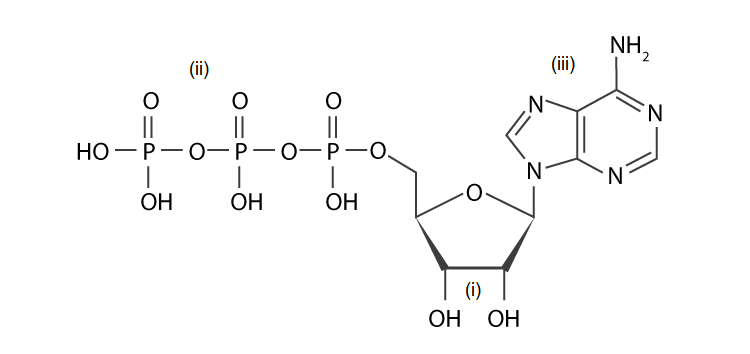
\(
\begin{array}{|l|l|l|l|}
\hline & \text { (i) } & \text { (ii) } & \text { (iii) } \\
\hline \text { (a) } & \text { Ribose } & \text { Triphosphate group } & \text { Adenine } \\
\hline \text { (b) } & \text { Adenine } & \text { Triphosphate group } & \text { Ribose } \\
\hline \text { (c) } & \text { Glucose } & \text { Triphosphate group } & \text { Adenine } \\
\hline \text { (d) } & \text { Ribose } & \text { Triphosphate group } & \text { Guanine } \\
\hline
\end{array}
\)CorrectIncorrectHint
a
-
Question 62 of 108
62. Question
Amount of energy released during hydrolysis of a high energy bond of ATP is
CorrectIncorrectHint
(d) Adenosine triphosphate (ATP) is the energy currency of the cell. It is the most important energy carrier which carries energy in the two terminal phosphate bonds (called as high energy bonds or energy-rich bonds). Equal amounts of usable energy are released per mole of ATP or ADP hydrolysis:
\(\mathrm{ATP}+\mathrm{H}_2 \mathrm{O} \rightleftharpoons \mathrm{ADP}+\mathrm{P}_{\mathrm{i}}+7.3 \mathrm{Kcal} \mathrm{mol}^{-1}\)
\(\mathrm{ADP}+\mathrm{H}_2 \mathrm{O} \rightleftharpoons \mathrm{AMP}+\mathrm{P}_i+7.3 \mathrm{Kcal} \mathrm{mol}^{-1}\) -
Question 63 of 108
63. Question
All of the following processes can release \(\mathrm{CO}_2\) except
CorrectIncorrectHint
c
-
Question 64 of 108
64. Question
Select the option that correctly fills the blanks in the following statements.
A. Glucose has (i) carbon atoms, pyruvic acid has (ii) carbon atoms and the acetyl group has (iii) carbon atoms.
B. Electrons enter the electron transport system as parts of hydrogen atoms attached to (i) and (ii).\(
\begin{array}{|l|l|l|}
\hline & \text { A } & \text { B } \\
\hline \text { (a) } & \text { (i)-6, (ii)-4, (iii)-3 } & \text { (i)-NADH, (ii)-F ADH_2 } \\
\hline \text { (b) } & \text { (i)-6, (ii)-3, (iii)-2 } & \text { (i)-NADH, (ii)-F ADH_2 } \\
\hline \text { (c) } & \text { (i)-6, (ii)-3, (iii)-2 } & \text { (i)-ATP, (ii)-GTP } \\
\hline \text { (d) } & \text { (i)-6, (ii)-4, (iii)-3 } & \text { (i)-ATP, (ii)-GTP } \\
\hline
\end{array}
\)CorrectIncorrectHint
b
-
Question 65 of 108
65. Question
Identify \(P, Q, R\) and \(S\) in the given diagram of the electron transport system.
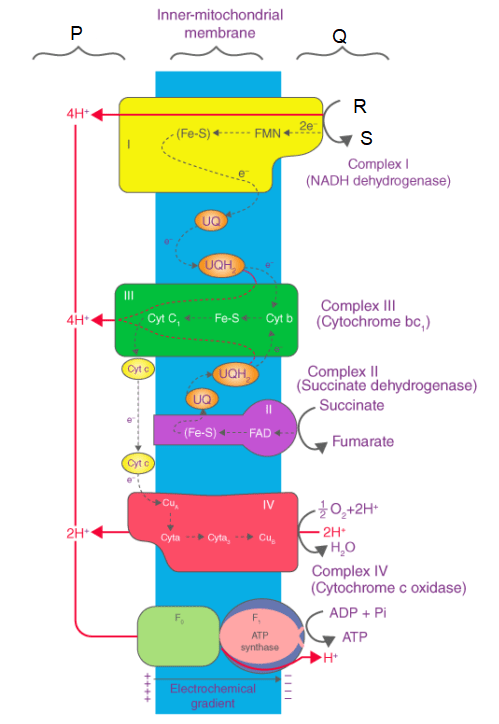 CorrectIncorrect
CorrectIncorrectHint
b
-
Question 66 of 108
66. Question
Match column I with column II and select the correct option from the given codes.
\(
\begin{array}{|c|l|c|l|}
\hline & \text { Column I } & & \text { Column II } \\
\hline \text { A. } & \text { Glycolysis } & \text { (i) } & \text { Inner mitochondrial membrane } \\
\hline \text { B. } & \text { TCA cycle } & \text { (ii) } & \text { Mitochondrial matrix } \\
\hline \text { C. } & \text { ETS } & \text { (iii) } & \text { Cytoplasm } \\
\hline
\end{array}
\)CorrectIncorrectHint
(b) Glycolysis takes place in cell cytoplasm, Kreb’s cycle or TCA cycle occurs in mitochondrial matrix. Whereas ETS is located on inner mitochondrial membrane.
-
Question 67 of 108
67. Question
Electron transport chain (ETC) is a set of ____ electron carriers present in a specific sequence along _____ mitochondrial membrane.
CorrectIncorrectHint
(a) In electron transport chain, there are 7 electron acceptors, which are as follows \(\mathrm{CO}{-} \mathrm{Q} \rightarrow \mathrm{Cyt} b \rightarrow \mathrm{Cyt} {~c_1} \rightarrow\) Cyt \(c \rightarrow\) Cyt \(a\) \(\rightarrow\) Cyt \(a_3 \rightarrow O_2\). Oxygen is the ultimate electron acceptor. These electron acceptors are present in a specific sequence along inner mitochondrial membrane.
-
Question 68 of 108
68. Question
In the electron transport system present in the inner mitochondrial membrane complexes I and IV are respectively
CorrectIncorrectHint
(c) Four major respiratory enzyme complexes of the electron transport chain are located on the inner mitochondrial membrane. These are :
Complex I (NADH dehydrogenase), complex II (succinate dehydrogenase), complex III (cytochrome \(b c\),) and cytochrome IV (cytochrome \(c\) oxidase). There is a fifth complex called ATP synthase which is involved in ATP synthesis. -
Question 69 of 108
69. Question
Oxidation of one NADH and one \(\mathrm{FADH}_2\) give rise to _____ and ______ ATP molecules respectively.
CorrectIncorrectHint
(a) Oxidation of one molecule of NADH gives rise to 3 molecules of ATP while that of one molecule of \(\mathrm{FADH}_2\) produces 2 molecules of ATP.
-
Question 70 of 108
70. Question
Study the incorrect statement with respect to an overview of the electron transport system (ETS).
CorrectIncorrectHint
(c) 3 ATPs are formed for every pair of electrons that enters by way of NADH and 2 ATPs are formed for every pair of electrons that enters by way of \(\mathrm{FADH}_2\).
-
Question 71 of 108
71. Question
Last \(e^{-}\)acceptor during ETS is
CorrectIncorrectHint
(a) In electron transport chain, there are 7 electron acceptors, which are as follows \(\mathrm{CO}{-} \mathrm{Q} \rightarrow \mathrm{Cyt} b \rightarrow \mathrm{Cyt} {~c_1} \rightarrow\) Cyt \(c \rightarrow\) Cyt \(a\) \(\rightarrow\) Cyt \(a_3 \rightarrow O_2\). Oxygen is the ultimate electron acceptor. These electron acceptors are present in a specific sequence along inner mitochondrial membrane.
-
Question 72 of 108
72. Question
Which of these are respiratory poisons or inhibitors of ETC?
CorrectIncorrectHint
(d) Site-specific inhibitors of electron transport prevent the passage of electrons by binding to a component of the chain, blocking the oxidation/reduction reaction.
Antimycin A, an antibiotic, blocks electron transport at the level of the \(\mathrm{COQH}_2\)-cytochrome c-reductase (Complex III).
Cyanide, azide and \(\mathrm{CO}\) bind with cytochrome oxidase complex and inhibit the terminal transfer of electrons to oxygen. -
Question 73 of 108
73. Question
During the electron transport system (ETS), electron transport proceeds from carriers that have ____ redox potential to those having _____ redox potential. This electron transport down the energy gradient leads to the formation of ATP from \(\mathrm{ADP}\) and \(\mathrm{Pi}\), which is referred to as _______.
CorrectIncorrectHint
a
-
Question 74 of 108
74. Question
Read the given statements and select the correct option.
Statement 1: During photophosphorylation (of photosynthesis), light energy is utilised for the production of proton gradient during ATP synthesis.
Statement 2: In respiration, energy of oxidation reduction is utilised for the phosphorylation and thus the process is called oxidative phosphorylation.CorrectIncorrectHint
(a) Photophosphorylation occurs in the grana and requires direct sunlight energy to make energy-carrier molecules that are used in the dark reaction. The light energy is trapped by chlorophyll to make ATP and NADPH. Oxidative phosphorylation is the synthesis of energy-rich ATP molecules with the help of energy liberated during oxidation of reduced co-enzymes ( \(\left.N A D H, F A D H_2\right)\) produced in respiration.
-
Question 75 of 108
75. Question
Identify A and B in the given diagram showing ATP synthesis in mitochondria.
 CorrectIncorrect
CorrectIncorrectHint
b
-
Question 76 of 108
76. Question
As per chemiosmotic coupling hypothesis, in mitochondria, protons accumulate in the
CorrectIncorrectHint
(c) Chemiosmotic coupling hypothesis, proposed by Peter Mitchell \((1961,66)\) (Nobel Prize in 1978), is the most widely accepted theory for oxidative phosphorylation. Reduced NAD (i.e., NADH), released from Krebs’ cycle, when enters in the ETS, transports three pairs of \(\mathrm{H}^{+}\)across the inner mitochondrial membrane to the intermembrane space. Similarly, NADH from glycolysis and \(\mathrm{FADH}_2\) from Krebs’ cycle also transport pairs of \(\mathrm{H}^{+}\) into intermembrane space. Each molecule of NADH released from glycolysis or \(\mathrm{FADH}_2\) from Krebs’ cycle transports two pairs of protons into intermembrane space. This unidirectional flow of protons results in the accumulation of protons in the intermembrane space.
-
Question 77 of 108
77. Question
Study the following statements regarding chemiosmotic hypothesis in mitochondria and select the correct ones.
(i) \(F_1\) headpiece contains the site for the synthesis of ATP from ADP + Pi.
(ii) \(F_0\) part forms the channel through which protons cross the inner membrane.
(iii) For each ATP produced, \(2 \mathrm{H}^{+}\)pass through \(\mathrm{F}_0\) from the intermembrane space to the matrix down the electrochemical proton qradient.CorrectIncorrectHint
d
-
Question 78 of 108
78. Question
Select the wrong statement.
CorrectIncorrectHint
(c) Cyanide is an inhibitor of complex IV (in ETS) and other heme – containing enzymes of mitochondria. Thus, cyanide blocks ATP production in the cells.
-
Question 79 of 108
79. Question
Which of the following cellular metabolic processes can occur both in the presence or absence of \(\mathrm{O}_2\)?
CorrectIncorrectHint
(a) Glycolysis is a process in which one molecule of glucose is partially oxidised into two molecules of pyruvate in a series of enzyme catalysed reactions. Glycolysis, the major pathway for glucose metabolism, occurs in the cytosol of all cells.
-
Question 80 of 108
80. Question
Match column I with column II and select the correct option from the codes given below.
\(
\begin{array}{|l|l|l|l|}
\hline & \text { Column I } & & \text { Column II } \\
\hline \text { A. } & \text { TCA cycle } & \text { (i) } & \begin{array}{l}
\text { Inner mitochondrial } \\
\text { membrane }
\end{array} \\
\hline \text { B. } & F_0-F_1{\text {, particles }} & \text { (ii) } & \text { Hans Krebs } \\
\hline \text { C. } & \begin{array}{l}
\text { End product of } \\
\text { glycolysis }
\end{array} & \text { (iii) } & \begin{array}{l}
\text { Oxidative } \\
\text { decarboxylation }
\end{array} \\
\hline \text { D. } & \begin{array}{l}
\text { Pyruvate } \\
\text { dehydrogenase }
\end{array} & \text { (iv) } & \text { Pyruvic acid } \\
\hline
\end{array}
\)CorrectIncorrectHint
a
-
Question 81 of 108
81. Question
Select the correct statements.
(i) Between temperature range \(0-25^{\circ} \mathrm{C}\), rate of respiration doubles for every \(10^{\circ} \mathrm{C}\) rise in temperature.
(ii) Cytochromes are iron-porphyrin compounds.
(iii) Respiratory rate of wounded or injured plant parts generally decreases.CorrectIncorrectHint
(a) Wounding or injuring an organ of a plant increases the rate of respiration. It is probably due to the formation of growth hormone, traumatic acid, which increases the meristematic activity, resulting in callus formation.
-
Question 82 of 108
82. Question
Which of the following statements is correct with respect to the effect of temperature on rate of respiration?
CorrectIncorrectHint
d
-
Question 83 of 108
83. Question
During complete metabolism of glucose, the number of ATP formed is
CorrectIncorrectHint
c
-
Question 84 of 108
84. Question
How many ATP molecules will be generated in a plant system during the complete oxidation of 40 molecules of glucose?
CorrectIncorrectHint
(c) 36 ATP molecules are produced during the complete oxidation of one molecule of glucose.
So, 40 molecules of glucose will produce \((36 \times 40)\) ATP =1440 ATP. -
Question 85 of 108
85. Question
The balance sheet for ATP production in glycolysis has been given below. Select the option which correctly fills up the blanks for P, Q, R and S. [‘ \(X\) ‘ stands for ‘nil’].
\(
\begin{array}{|l|l|l|l|}
\hline \text { Steps } & \text { ATP Utilisation} & \text { ATP Production} \\
\hline \text { 1. } & \text { Glucose } \rightarrow \text { Glucose-6- phosphate } & \text { P } & \text { X } \\
\hline \text { 2. } & \begin{array}{l}
\text { Fructose-6-phosphate } \rightarrow \text { Fructose-1, } \\
\text { 6- bisphosphate }
\end{array} & \text { 1 } & \text { Q } \\
\hline \text { 3. } & \begin{array}{l}
\text { 1, 3-bisphosphoglyceric acid } \rightarrow 3- \\
\text { Phosphoglyceric acid }
\end{array} & \text { X } & \text { R } \\
\hline \text { 4. } & \begin{array}{l}
\text { 2-Phosphoenol pyruvic acid } \rightarrow \\
\text { Pyruvic acid }
\end{array} & \mathbf{S} & \mathbf{2} \\
\hline
\end{array}
\)CorrectIncorrectHint
b
-
Question 86 of 108
86. Question
Refer to the given figure and select the correct option for A, B, C and D.
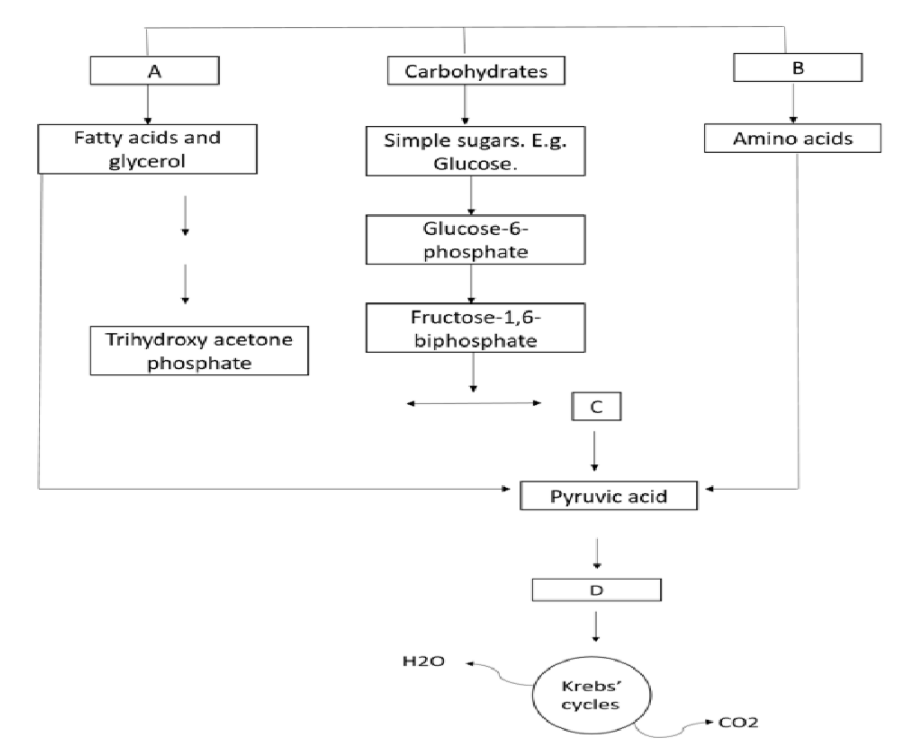
\(
\begin{array}{|l|l|l|l|l|}
\hline & \text { A } & \text { B } & \text { C } & \text { D } \\
\hline \text { (a) } & \text { Fats } & \text { Proteins } & \text { 3-PGAL } & \text { Acetyl CoA } \\
\hline \text { (b) } & \text { Fats } & \text { Proteins } & \text { 3-PGAL } & CO_2 \\
\hline \text { (c) } & \text { Proteins } & \text { Fats } & \text { Acetyl CoA } & \text { PEP } \\
\hline \text { (d) } & \text { Proteins } & \text { Fats } & \text { PEP } & \text { Acetyl CoA } \\
\hline
\end{array}
\)CorrectIncorrectHint
a
-
Question 87 of 108
87. Question
Which of the following statements regarding metabolic pathways is incorrect?
CorrectIncorrectHint
d
-
Question 88 of 108
88. Question
Respiratory pathway is
CorrectIncorrectHint
(b) The same respiratory process which acts as catabolic pathway for respiratory substrates also acts as anabolic pathway for the synthesis of various intermediary metabolic products and secondary metabolites. The respiratory pathway, therefore acts both as catabolic as well as anabolic pathway. Thus, it is better to call it amphibolic pathway rather than catabolic pathway.
-
Question 89 of 108
89. Question
Respiratory quotient may be represented as
CorrectIncorrectHint
(b) During aerobic respiration, \(\mathrm{O}_2\) is consumed and \(\mathrm{CO}_2\) is released. The ratio of the volume of \(\mathrm{CO}_2\) evolved to the volume of \(\mathrm{O}_2\) consumed in respiration over a period of time is called as respiratory quotient \((\mathrm{RQ})\) or respiratory ratio.
\(
\mathrm{RQ}=\frac{\text { Volume of } \mathrm{CO}_2 \text { evolved }}{\text { Volume of } \mathrm{O}_2 \text { consumed }}
\) -
Question 90 of 108
90. Question
Which out of the following statements is incorrect?
CorrectIncorrectHint
c
-
Question 91 of 108
91. Question
Respirometer is an instrument used to measure
CorrectIncorrectHint
(c) Respirometer is an instrument used for measuring rate of respiration and respiratory quotient.
-
Question 92 of 108
92. Question
Refer the given equation.
\(
2\left(\mathrm{C}_{51} \mathrm{H}_{98} \mathrm{O}_6\right)+145 \mathrm{O}_2 \rightarrow 102 \mathrm{CO}_2+98 \mathrm{H}_2 \mathrm{O}+\text { Energy }
\)
The \(R Q\) in this case isCorrectIncorrectHint
(b) When fats are used in respiration, the RQ is less than 1, e.g., for the breakdown of tripalmitin,
\(
R Q=\frac{102 \mathrm{CO}_2}{145 \mathrm{O}_2}=0.7
\) -
Question 93 of 108
93. Question
Consider the following statements with respect to respiration.
(i) Glycolysis occurs in the cytoplasm of the cell.
(ii) Aerobic respiration takes place within the mitochondria.
(iii) Electron transport system is present in the outer mitochondrial membrane.
(iv) \(\mathrm{C}_{51} \mathrm{H}_{98} \mathrm{O}_6\) is the chernical formula of tripalmitin, a fatty acid.
(v) Respiratory quotient \(=\frac{\text { Volume of } \mathrm{O}_2 \text { evolved }}{\text { Volume of } \mathrm{CO}_2 \text { consumed }}\) Of the above statementsCorrectIncorrectHint
(a) Electron transport system is present on the inner mitochondrial membrane. Respiratory quotient (RQ) is the ratio of the volume of \(\mathrm{CO}_2\) evolved to the volume of \(\mathrm{O}_2\) consumed, i.e.,
\(
\mathrm{RQ}=\frac{\text { Volume of } \mathrm{CO}_2 \text { evolved }}{\text { Volume of } \mathrm{O}_2 \text { consumed }} .
\) -
Question 94 of 108
94. Question
Select the wrong statement.
CorrectIncorrectHint
(b) The intermediate compound which links glycolysis with Krebs’ cycle is acetyl CoA.
-
Question 95 of 108
95. Question
RQ of proteins, carbohydrates, fats and organic acids are in order
CorrectIncorrectHint
a
-
Question 96 of 108
96. Question
Select the correct combination of the respiratory substrates and their respective RQs.
CorrectIncorrectHint
a
-
Question 97 of 108
97. Question
Match column I with column II and select the correct option from the codes given below.
\(
\begin{array}{|l|l|l|l|}
\hline & \text { Column I } & & \text { Column II } \\
\hline \text { A. } & \text { RQ } & \text { (i) } & \text { Chemiosmotic ATP synthesis } \\
\hline \text { B. } & \text { Mitchel } & \text { (ii) } & \text { Muscle fatigue } \\
\hline \text { C. } & \text { Cytochromes } & \text { (iii) } & \text { Inner mitochondrial membrane } \\
\hline \text { D. } & \text { Lactic acid } & \text { (iv) } & \text { Alcoholic fermentation } \\
\hline \text { E. } & \text { Yeast } & \text { (v) } & \text { Respirometer } \\
\hline
\end{array}
\)CorrectIncorrectHint
b
-
Question 98 of 108
98. Question
If volume of \(\mathrm{CO}_2\) liberated during respiration is more than the volume of \(\mathrm{O}_2\) used, then the respiratory substrate will be
CorrectIncorrectHint
(d) RQ slightly more than unity is found when organic acids are broken down as respiratory substrates under aerobic conditions, e.g. for the breakdown of oxalic acid,
\(
\mathrm{RQ}=\frac{4 \mathrm{CO}_2}{\mathrm{O}_2}=4.0
\) -
Question 99 of 108
99. Question
Value of RQ in succulents is
CorrectIncorrectHint
(d) Succulents do not evolve carbon dioxide during night (when their stomata are open) as the same is used in carbon fixation. They also change carbohydrates to organic acids which utilise oxygen but do not evolve carbon dioxide.
\(
2 \mathrm{C}_6 \mathrm{H}_{12} \mathrm{O}_6+3 \mathrm{O}_2 \longrightarrow 3 \mathrm{C}_4 \mathrm{H}_6 \mathrm{O}_5 +3 \mathrm{H}_2 \mathrm{O} \\
\)\(
\mathrm{RQ}=\frac{\text { Zero } \mathrm{CO}_2}{3 \mathrm{O}_2}=\text { Zero }
\) -
Question 100 of 108
100. Question
RQ in anaerobic respiration is
CorrectIncorrectHint
(d) In anaerobic respiration, there is no consumption of oxygen and carbon dioxide is produced in most of the cases. Therefore, the respiratory quotient is infinity. Carbohydrate is the usual substrate.
\(\mathrm{C}_6 \mathrm{H}_{12} \mathrm{O}_6 \stackrel{\text { Zymase }}{\longrightarrow} 2 \mathrm{CO}_2+2 \mathrm{C}_2 \mathrm{H}_5 \mathrm{OH}\)
\(
\mathrm{RQ}=\frac{2 \mathrm{CO}_2}{\text { Zero } \mathrm{O}_2}=\text { infinity }(\propto)
\) -
Question 101 of 108
101. Question
Study carefully the following statements and select the incorrect ones.
(i) When fats are used in respiration, the RQ is more than unity because fats contain more \(\mathrm{O}_2\) and require relatively less amount of \(\mathrm{O}_2\) for oxidation.
(ii) The most important energy carrier is ATP. This energy-rich compound is mobile and can pass from one cell to another.
(iii) Before pyruvic acid enters Krebs’ cycle, one of the two carbon atoms of pyruvic acid is reduced to carbon dioxide in the reaction called reductive carboxylation.
(iv) A special electron carrier system located in the mitochondrial membrane is called shuttle system. It transfers electrons from the hydrogens of cytoplasmic NADH to the mitochondrial electron carriers across the mitochondrial membrane.
(v) Zymase is a complex mixture of many enzymes which requires several coenzymes for its action. The enzyme complex-zymase catalyses series of reactions taking place during fermentation leading to the production of ethyl alcohol.CorrectIncorrectHint
(c) When fats are used as respiratory substrates, RQ is usually less than one. Fats are hydrolysed during respiration to glycerol and fatty acids. Complete oxidation of glycerol results in 10the \(R Q\) of 0.86 . The fatty acids, being poorer in oxygen, require more \(\mathrm{O}_2\) for complete oxidation. ATP (Adenosine triphosphate) is the most important energy carrier. ATP is mobile and transports the chemical energy to the energy consuming processes anywhere within the cell, however, the ATP molecules do not pass from one cell to another. Pyruvic acid, generated in the glycolysis, enters into mitochondrial matrix and one of the three \(C\) atoms of pyruvic acid undergoes oxidative decarboxylation before it enters Krebs’ cycle.
-
Question 102 of 108
102. Question
Select the incorrect statement with respect to the given representation.
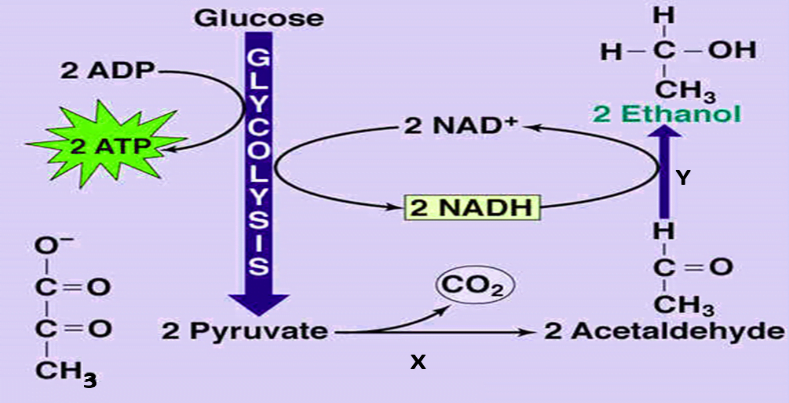 CorrectIncorrect
CorrectIncorrectHint
(a) The given representation depicts ethyl alcohol fermentation (alcoholic fermentation), which is quite common in some fungi (e.g., yeast, Rhizopus) and bacteria. X is the enzyme pyruvate decarboxylase and Y is the enzyme alcohol dehydrogenase.
-
Question 103 of 108
103. Question
Refer to the following flow chart representing cellular respiration and its fuels. Select the option that correctly fill the blanks 1,2,3,4,5,6 and 7 respectively.
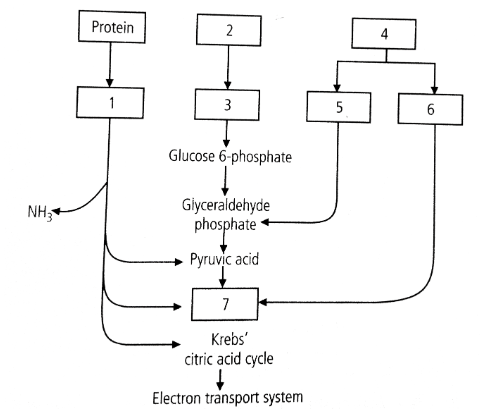 CorrectIncorrect
CorrectIncorrectHint
a
-
Question 104 of 108
104. Question
Study the given figure and select the incorrect option regarding this.
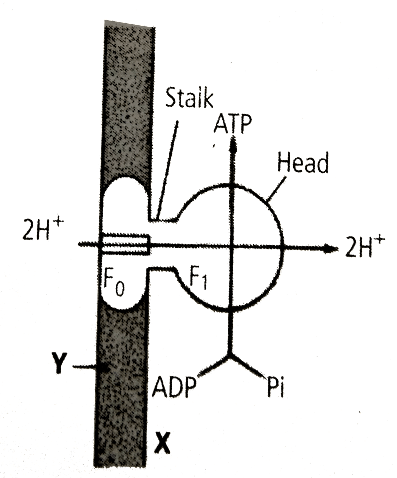 CorrectIncorrect
CorrectIncorrectHint
(d) ATP synthase is located in \(F_1\) or head piece of \(F_0-F_1\) or elementary particles. The particles are present in the inner mitochondrial membrane. ATP-synthase becomes active in ATP formation only when there is a proton gradient having a higher concentration of \(\mathrm{H}^{+}\)or protons on the \(\mathrm{F}_0\) side as compared to \(F_1\) side. Increased proton concentration is produced in the outer chamber or outer surface of the inner mitochondrial membrane by the pushing of protons with the help of energy liberated by the passage of electrons from one carrier to another.
-
Question 105 of 108
105. Question
Given below is the simplified system of terminal oxidation and oxidative phosphorylation.
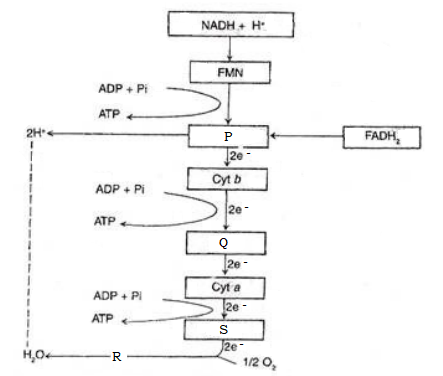
Identify P, Q, R and S and select the correct option.
\(
\begin{array}{|l|l|l|l|}
\hline {\mathbf{P}} & {\mathbf{Q}} & {\mathbf{R}} & {\mathbf{S}} \\
\hline \text { a. Cyt } a_3 & \text { UQ } & \text { Cyt } c & 2 \mathrm{H}^{+} \\
\hline \text { b. UQ } & \text { Cyt } c & \mathrm{O}_2 & \text { Cyt } a_3 \\
\hline \text { c. Cyt } b & \mathrm{QH}_2 & 2 \mathrm{H}^{+} & \text {Cyt } c \\
\hline \mathrm{d. QH}_2 & \text { Cyt } b & \mathrm{O}_2 & \text { Cyt } c \\
\hline
\end{array}
\)CorrectIncorrectHint
b
-
Question 106 of 108
106. Question
In addition to the normal process of oxidation of carbohydrates through glycolysis and Krebs’ cycle, there is another process by which plants could oxidise carbohydrates to obtain energy. In this process, hexose sugars undergo oxidative degradation through 5-C sugar intermediates and hence it is known as Pentose phosphate pathway (PPP). Which of the following statements is not true with regard to PPP?
CorrectIncorrectHint
(c) Pentose phosphate pathway (PPP) or hexose monophosphate shunt (HMP pathway) occurs in cytoplasm in most organisms, however in plants, many of its steps occur in plastids also.
-
Question 107 of 108
107. Question
Mechanism of phosphorylation is depicted in the diagram below. Study it carefully and mark the correct option.
CorrectIncorrectHint
b
-
Question 108 of 108
108. Question
The given graph shows the respiratory quotient (R. Q.) of five substrates.
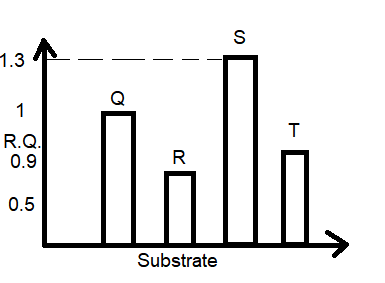
Select the option that correctly identifies substrates P, Q, \(\mathrm{R}, \mathrm{S}\) and \(\mathrm{T}\).
\(
\begin{array}{|l|l|l|l|l|}
\hline {\text { P }} & {\text { Q }} & {\text { R }} & {\text { S }} & {\text { T }} \\
\hline \text { a. Tripalmitin } & \text { Oxalic acid } & \text { Protein } & \text { Fructose } & \begin{array}{l}
\text { Succinic } \\
\text { acid }
\end{array} \\
\hline \text { b. Malic acid } & \begin{array}{l}
\text { Succulent } \\
\text { carbohydrate }
\end{array} & \text { Sucrose } & \text { Protein } & \text { Triolein } \\
\hline \begin{array}{l}
\text { c. Succulent } \\
\text { carbohydrate }
\end{array} & \begin{array}{l}
\text { Glucose }
\end{array} & \text { Tripalmitin } & \begin{array}{l}
\text { Malic } \\
\text { acid }
\end{array} & \text { Protein } \\
\hline \text { d. Triolein } & \text { Protein } & \text { Oxalic acid } & \text { Maltose } & \text { Tripalmitin } \\
\hline
\end{array}
\)CorrectIncorrectHint
(c) Respiratory quotient is equal to unity if carbohydrate is respiratory substrate \(R Q\) is 0.7 when fats (triolein, tripalmitin, etc.) are respiratory substrates. R.Q. is 0.9 when protein are respiratory substrates. R.Q. is zero when succulents convert carbohydrates to organic acids. R.Q. is more than unity when organic acid are respiratory substrates.